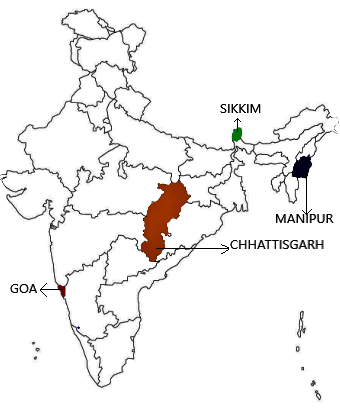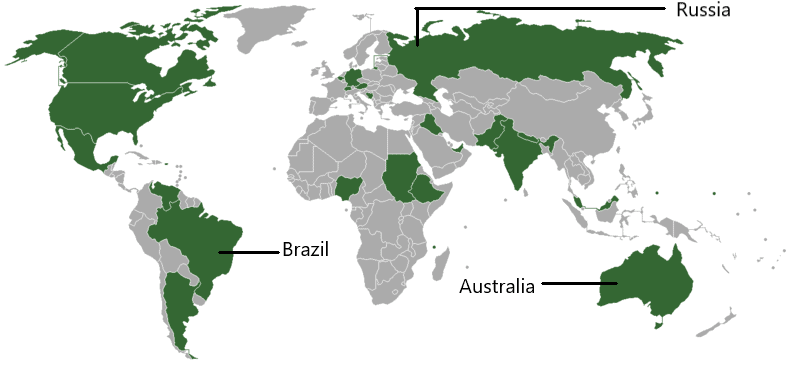Ques 1: Locate the following States on a blank outline map of India:
Manipur, Sikkim, Chhattisgarh and Goa.
Ans.

Ques 2: Identify and shade three federal countries (other than India) on a blank outline map of the world.
Ans.

Ques 3: Point out one feature in the practice of federalism in India that is similar to and one feature that is different from that of Belgium.
Ans. (a) Similar feature: Distribution of powers- (i) In both the countries, power has been divided among the national government, state (provincial) governments and local governments (community govt, in Belgium).
(ii) In Belgium, the community government has the power regarding cultural, educational and language-related issues.
(iii) In India, the legislative powers are divided as mentioned in the Union List, State List and Concurrent List. In addition to this by the Act of 1992, the local governments have been granted more powers.
(b) Different feature: In Belgium in addition to Central and State government, there is a third kind of government that is community government. This is elected by people belonging to one language community - Dutch, French and German-speaking no matter where they live. This government deals with cultural, educational and language-related issues. In India, there is no such government.
In India, there is a three-tier government. The third government is the local government i.e., Panchayats at village level and Municipalities at the town level.
Ques 4: What is the main difference between a federal form of government and a unitary one? Explain with an example.
Ans.
(a) Under a federal form of government,
(i) There are two or three sets of government i.e., national, state and local government.
(ii) Powers are distributed among them. National government makes law on subjects of national importance such as defence and foreign affairs.
(iii) The state governments make laws on subjects of state importance such as police.
(iv) The local governments make laws on subjects of local importance.
(b) On the other hand, under the unitary system,
(i) There is only one level of government at the national level. There are no provincial or state or local government
(ii) There is no division of powers and the units or provincial governments are subordinate to the national government which enjoys all powers.
Ques 5: State any two differences between the local government before and after the Constitutional amendment in 1992.
Ans. Two differences between the local government before and after the constitutional amendment in 1992 are as follows:
(i) Before 1992, elections to the local bodies were not held regularly. Since 1992, it is constitutionally mandated to hold regular elections to local government bodies.
(ii) Before 1992, local bodies did not have any powers or resources of their own. After 1992, the state governments are required to share some powers and revenue with local government bodies.
Ques 6: Fill in the blanks:
Since the United States is a (i) ___________________ _ type of federation, all the Constituent States have equal powers and States are (ii)________________vis-a-vis the federal government. But India is a (iii) ___ ___________ type of federation and some States have more power than others. In India, the (iv) __________ government has more powers.
Ans. (i) coining together (ii) strong (iii) holding together (iv) central
Ques 7: Here are three reactions to the language policy followed in India. Give an argument and an example to support any of these positions.
Sangeeta: The policy of accommodation has strengthened national unity.
Arman: Language-based States have divided us by making everyone conscious of their language.
Harish: This policy has only helped to consolidate the dominance of English over all other languages.
Ans. The position held by Sangeeta that the policy of accommodation has strengthened national unity is correct. The Central Government agreed to continue the use of English along with Hindi for official purposes to avoid the Lankan kind of situation. Otherwise, the movement against Hindi would have taken more ugly turn. Promotion of Hindi continues to be the official policy of the Government of India. The flexibility in the policy has proved to be in the interest of the country. Thus the policy of accommodation has strengthened national unity. Hindi is being used along with English for official purposes.
Ques 8: The distinguishing feature of a federal government is:
(а) National government gives some powers to the provincial government.
(b) Power is distributed among the legislature, executive and judiciary.
(c) Elected officials exercise supreme power in the government.
(d) Governmental power is divided between different levels of government.
Ans. (d) Governmental power is divided between different levels of government.
Ques 9: A few subjects in various Lists of the Indian Constitution are given here. Group them under the Union, State and Concurrent Lists as provided in the table below:
A. Defence; B. Police; C. Agriculture; D. Education; E. Banking; F. Forests; G. Communications; H. Trade; I. Marriages
| Union List | |
| State List | |
| Concurrent List |
Ans. (i) Union List: Defence, Banking and Communications.
(ii) State List: Police, Agriculture and Trade.
(iii) Concurrent List: Education, Forests and Marriages.
Ques 10: Examine the following pairs that give the level of government in India and the powers of the government at that level to make laws on the subjects mentioned against each. Which of the following pairs is not correctly matched?
| (a) State government | State List |
| (b) Central government | Union List |
| (c) Central and State governments | Concurrent List |
| (d) Local governments | Residuary powers |
Ans. (d) Local governments — Residuary powers.
It is not correctly matched because the residuary powers have been given to the Central Government.
Ques 11: Match List I with List-II and select the correct answer using the codes given below the lists:
| List I | List II |
| 1. Union of India | A Prime Minister |
| 2. State | B. Sarpanch |
| 3. Municipal Corporation | C. Governor |
| 4. Gram Panchayat | D. Mayor |
| 1 | 2 | 3 | 4 | |
| (a) | D | A | B | C |
| (b) | B | C | D | A |
| (c) | A | C | D | B |
| (d) | C | D | A | B |
Ans. (c)A, C, D, B.
Ques 12: Consider the following statements:
A. In a federation, the powers of the federal and provincial governments are clearly demarcated.
B. India is a federation because the powers of the Union and State Governments are specified in the Constitution and they have exclusive jurisdiction on their respective subjects.
C. Sri Lanka is a federation because the country is divided into provinces.
D. India is no longer a federation because some powers of the States have been devolved to the local government bodies.
Which of the statements given above are correct?
(a) A, B and C
(b) A, C and D
(c) A and B only
(d) B and C only
Ans. (c) A and B only.



No comments:
Post a Comment